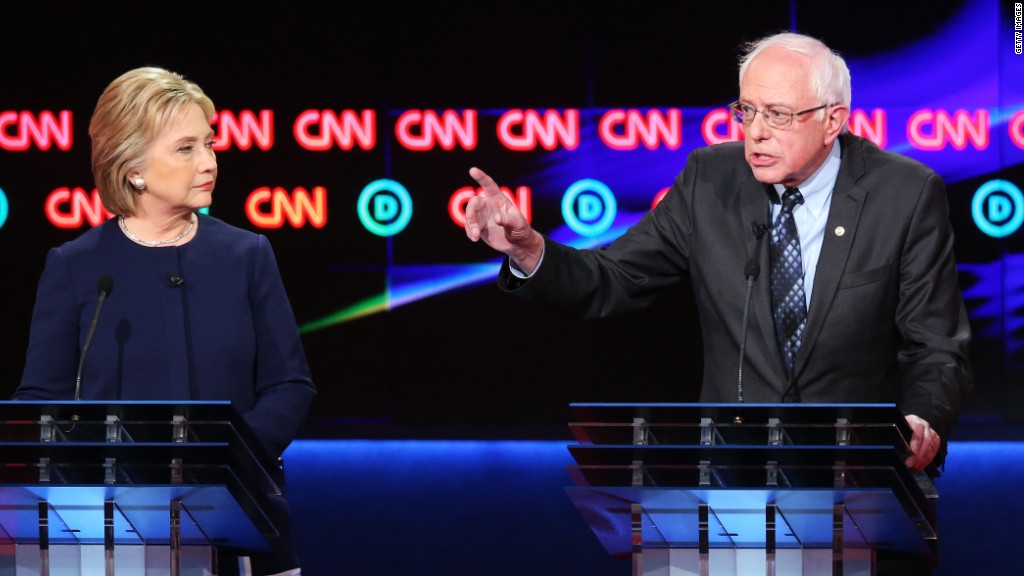
Bernie Sanders and Donald Trump agree on one thing: They say trade is killing the American Dream.
And Washington is to blame. Both candidates strongly denounce the nation's trade policy, saying it's shrinking the middle class and costing Americans jobs. Voters seem to agree, handing Sanders and Trump big wins in the nation's manufacturing heartland in Michigan.
"Those trade policies, as much as any other set of policies, has resulted in the shrinking of the American middle class," Sanders said at CNN's debate on Sunday.
But what are the facts?
CNNMoney wants to know: Are YOU worried about the economy?
Trade's impact on jobs has long been the subject of much debate.
Unions and left-leaning think tanks denounce trade deals like NAFTA as job killers, while conservative and free market experts say trade has benefited Americans, particularly by lowering prices.
The truth is somewhere in between. Trade has prompted factories to close and jobs to move overseas. And that has hurt certain communities. But global commerce and trade agreements are not the main cause for the troubled middle class.
"Trade is a factor, but technological change has been more important," said Robert Lawrence, professor of international trade at Harvard's Kennedy School of Government.
Related: Why Americans are so angry in 2016
What's clear is the middle class has shrunk. Middle class Americans now comprise less than half, or 49.9%, of the nation's population, down from 61% in 1971, according to the Pew Research Center.
What's less commonly known, however, is that more people are moving up the economic ladder than down. Those most likely to fall into the lower class are those with only a high school degree and high school dropouts.
Manufacturing was once a path to the middle class for these folks. In the 1960s, 28% of American workers were employed in manufacturing. That's down to 8.7% today, said Edward Leamer, economics professor at the University of California, Los Angeles.
"What's a high school graduate going to do?" Leamer said. "They used to be able to get manufacturing jobs."
Trade policies, particularly NAFTA and China's entry into the World Trade Organization, are often blamed for accelerating the decline in American factory jobs.
But, the manufacturing sector actually gained jobs initially: The nation added 23 million positions in the six years following NAFTA's passage in 1994. Factory employment didn't decline until after 2001, Lawrence said.
Looking specifically at China, one study found that the U.S. lost 1.5 million manufacturing jobs due to growing exports from China between 1991 and 2007. That accounts for about 20% of all manufacturing jobs shed over that period.
Yet, it's not clear how much free trade deals drove those trends.
Corporate America was already shifting jobs to lower-wage countries, said John McLaren, a University of Virginia economics professor. China's shift to a more market-driven economy drew U.S. companies looking for cheap labor to manufacture their goods, from sweatshirts to iPhones.
"These are trends that would have gone on," McLaren said.
Related: It would be hard for Trump to bring jobs back from China
The bigger culprit is technology, which has boosted productivity but made it more costly to manufacture in the U.S. Also, today's factory jobs require more education and skills, leaving many less-educated Americans on the sidelines.
Equally as important is the nation's shift to a service economy. The share of consumer spending on goods, such as cars, appliances and food, has fallen to one-third, down from half in 1970, Lawrence said.
Meanwhile, people are shelling out more on services, including entertainment and food, but also legal and health care needs.
"As people have gotten richer, they have personal trainers," Lawrence said, as an example of how Americans spend their money today.
Trade has also greatly benefited many middle class and working Americans by lowering the price of many products they buy. This has allowed them to spend their money on other items, including housing and education.
If we raised tariffs, as Trump has suggested, it might boost employment in the U.S. but it would also hike many Americans' cost of living.
"The benefits and jobs would be offset by higher prices," Leamer said.


